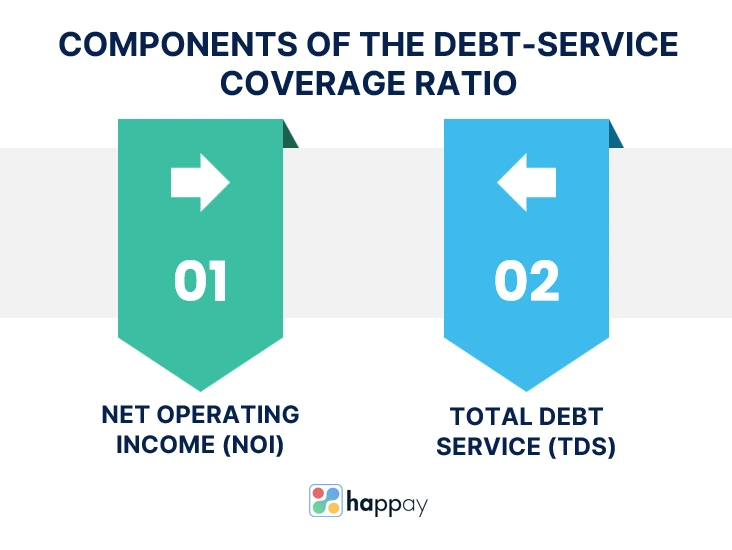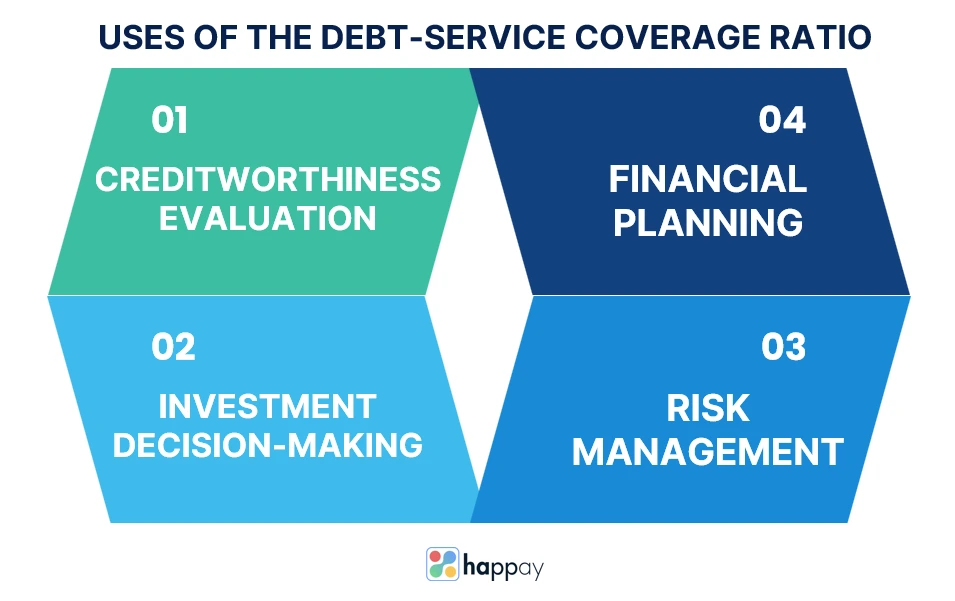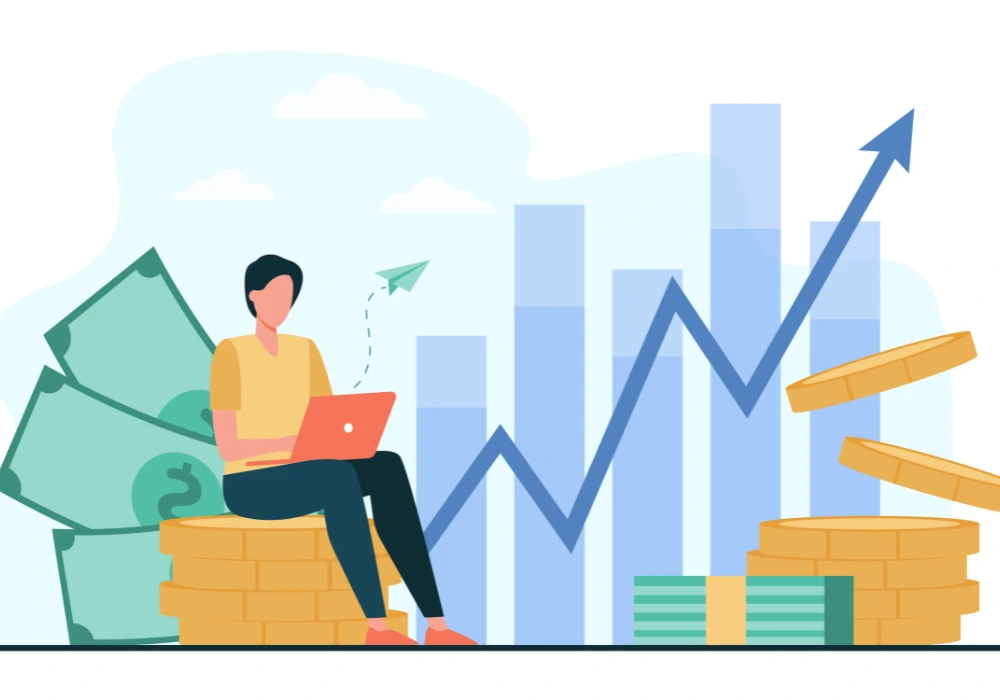Last Updated on November 28, 2025
Introduction
The debt-service coverage ratio (DSCR) is a crucial financial metric focusing on an organization’s ability to manage debt obligations. It is not just one of the many other metrics but an accurate calculation that can yield several benefits. Besides assessing the company’s financial health, it also supports the decision-making process for borrowing and investments.
This guide is an ideal starting point to help you understand the concept of DSCR better and know its related calculations. Apart from focusing on its significance in financial analysis, we will also explore the methodologies for calculating the DSR accurately. So, let’s understand how DSCR can help you meet your financial obligations better and help you make prudent financial decisions.
Read About: Expense Ratio: What is it, Components, Formula and How to Calculate?
What is the debt-service coverage ratio?
The debt-service coverage ratio (DSCR) helps assess an entity’s capacity to meet its debt obligations with its operational income. The DSCR quantifies an entity’s ability to generate enough cash flow to cover its debts.
You can calculate it by dividing the company’s income by total debt service (interest and principal repayments). A DSCR value exceeding 1 indicates that the entity generates more than enough income to cover its current debt obligations. In other words, it signifies a healthy financial position. Conversely, a DSCR below 1 implies that the entity may face challenges meeting its debt obligations.
Importance of DSCR in financial management
Here are some points highlighting the importance of DSCR in effective financial management.

1. Risk mitigation
DSCR is an early warning system for potential financial distress. Assessing the ratio helps financial managers identify scenarios where operational income may fall short of covering debt obligations.
2. Borrowing decisions
Financial managers use the DSCR to assess the organization’s capacity to service additional debt when considering new debt obligations. A thorough understanding of the DSCR helps make well-informed borrowing decisions and ensures the organization can comfortably manage its debt portfolio and financial statements.
3. Lender and investor confidence
Lenders and investors check the DSCR as a critical indicator of creditworthiness. A favorable DSCR showcases an organization’s ability to meet annual debt payments to instill stakeholder confidence. It can translate into more favorable lending terms and heightened investor trust.
4. Planning
DSCR provides insights into the organization’s financial health and guides the creation of effective financial strategies. Whether expanding operations or navigating economic uncertainties, a clear understanding of the DSCR enables strategic decision-making.
5. Performance benchmarking
Financial managers compare the DSCR over time or against industry standards. It helps them gauge the effectiveness of financial management practices and adapt strategies to optimize debt service capabilities.
Read More: 10 Best Financial Management Tools for CFOs
Components of the debt-service coverage ratio
Here are the primary components contributing to the calculation of the DSCR.

1. Net operating income (NOI)
The NOI represents the revenue generated by an entity’s core operational activities. You can derive the figure by subtracting operating expenses, excluding interest and taxes, from the total revenue. A higher NOI indicates a more substantial capacity to cover debt service requirements.
2. Total debt service (TDS)
The TDS includes all debt-related payments, including principal and interest. It provides a comprehensive view of the financial obligations of servicing the entity’s debt. It is a crucial denominator in the DSCR formula that enables a precise assessment of the proportion of income allocated to debt servicing.
Quick Read: What are Non-operating Expenses? – Definition, Calculation and Examples
What is the debt-service coverage ratio formula
The DSCR formula is as follows:
DSCR = Net Operating Income / Total Debt Service
- Net operating income (NOI): It represents the revenue generated from core operational activities, excluding interest and income tax.
- Total debt service (TDS): It comprises all debt-related payments, including principal and interest.
Example of the debt-service coverage ratio
Here’s an explanation of how to calculate the debt service coverage ratio.
Let’s consider the example of an organization generating an annual net operating income of ₹ 15 crore. On the other hand, its total debt service, including principal and interest payments, is ₹ 12 crore.
We can calculate the debt-service coverage ratio for this scenario as follows:
DSCR = Net Operating Income / Total Debt Service
DSCR = ₹ 15 Crore / ₹ 12 Crore = 1.25.
The DSCR of 1.25 indicates that the organization generates 1.25 times the income needed to cover its debt obligations. It suggests a healthy financial position and a positive capacity to meet debt service requirements.
Uses of the debt-service coverage ratio
Here are some of the principal uses of the DSCR.

1. Creditworthiness evaluation
Lenders use the DSCR as a fundamental tool to assess the creditworthiness of borrowers. A higher DSCR signifies a better ability to cover debt service payments. It provides lenders with a quantitative measure to gauge the risk of default.
2. Investment decision-making
Investors add the DSCR into their analyses when evaluating potential investments. A favorable DSCR indicates that an entity has the financial capacity to service its debt to make it an attractive investment opportunity.
3. Risk management
The comparison of operational income to debt service requirements helps stakeholders identify potential financial vulnerabilities. The approach allows for implementing risk mitigation measures to safeguard the entity against economic challenges.
4. Financial planning
Financial managers use the DSCR to gain insights into an organization’s financial health and formulate effective financial strategies. Whether contemplating expansion or capital projects, the DSCR guides enhanced financial planning by offering a clear perspective on debt service capabilities.
Read More: TOP 10 Financial Planning Tools
What is a good debt-service coverage ratio?
Assessing what constitutes a “good” DSCR involves considering the following factors.
1. DSCR above 1
A DSCR above 1 signifies that the entity generates more income than required to cover its debt obligations. Values above 1 indicate a surplus and suggest financial strength with a lower risk of default.
2. Industry standards
Industry standards may influence what can be acceptable as a good DSCR. This is because different sectors and business models have varying risk tolerance levels. Therefore, comparing your entity’s DSCR with industry benchmarks is advisable to contextualize the financial position.
3. Lender requirements
Lenders often have specific DSCR requirements when extending credit. Meeting or exceeding these requirements is crucial for favorable lending terms. Lenders may consider a DSCR below one as a sign of financial risk, which can impact loan approval and terms.
4. Project-specific considerations
A higher DSCR can account for uncertainties and provide a safety margin for new projects. Project-specific considerations influence a satisfactory DSCR in the context of investment decisions.
5. Financial strategy
Some organizations may aim for a more conservative DSCR to ensure a robust financial position. Conversely, others may strategically manage a lower ratio based on their risk appetite.
Learn About: Financial System: What is it, Importance, Components, Functions & Challenges
Pros and cons of the debt-service coverage ratio
While DSCR provides critical insights into financial health, it is essential to acknowledge both the advantages and limitations associated with it.
Pros
- Risk assessment: DSCR is an effective tool for assessing the risk of default by evaluating an entity’s capacity to cover its debt obligations.
- Lender confidence: Lenders rely on the DSCR to gauge the creditworthiness of borrowers. A favorable DSCR instills confidence in lenders, which can lead to more favorable lending terms.
- Investor decision-making: Investors use the DSCR to evaluate the financial viability of potential investments. A strong DSCR signals financial stability.
- Financial planning: Financial managers use the DSCR for advanced financial planning. It aids in formulating effective financial strategies and optimizing debt management.
Cons
- Sensitivity to economic conditions: DSCR may be sensitive to economic fluctuations and impact an entity’s ability to generate consistent income. Economic downturns can result in lower operational income, affecting the DSCR unfavorably.
- Limited context: While DSCR provides a quantitative measure of financial health, it may not capture the complete economic context. It does not account for changes in market conditions and operational inefficiencies.
- Project-specific limitations: For new projects or ventures, the DSCR may have limitations in predicting future cash flows accurately. Projections may be subject to uncertainties and impact the reliability of the DSCR.
- Ignored timing of cash flows: The DSCR does not consider the timing of cash flows. It can overlook short-term fluctuations that impact an entity’s ability to meet debt obligations.
Real-world applications of debt-service coverage ratio
Here are a few examples illustrating DSCR’s application in different sectors.
1. Real estate development
A real estate development company seeks financing for a new commercial project. Lenders, assessing the creditworthiness of the project, use the DSCR to evaluate its ability to generate sufficient income for debt service.
DSCR, in this example, assists lenders in determining the project’s financial viability. If the calculated DSCR is favorable (e.g., above 1.25), it signals to lenders that the project has a capable income stream to cover debt payments.
2. Manufacturing industry
Let’s consider that a manufacturing company expands its production facilities and requires additional financing. The company’s financial team uses the DSCR to assess whether the projected operational income adequately serves the increased debt load.
The DSCR, in this scenario, provides the financial team with a quantitative measure of the company’s ability to manage the additional debt associated with the expansion. If the calculated DSCR meets or exceeds predetermined benchmarks, it signals to decision-makers that the expansion is financially viable and aligns with the company’s debt management strategy.
Debt-service coverage ratio vs. interest coverage ratio?
Both the debt-service coverage ratio (DSCR) and the interest coverage ratio (ICR) are essential financial metrics. However, they differ in the following key aspects.
Criteria |
Debt-service coverage ratio (DSCR) |
Interest coverage ratio (ICR) |
|
Scope of analysis |
Comprises debt service obligations, including principal and interest. |
Focuses specifically on the ability to cover interest payments. |
|
Components |
Considers principal and interest payments in the calculation. |
Considers only interest payments in the calculation. |
|
Assessment |
Provides a holistic view of an entity’s capacity to meet all aspects of its debt. |
Offers a more targeted assessment of an entity’s ability to service interest obligations. |
|
Risk evaluation |
Useful for assessing the overall risk of default, considering all debt obligations. |
Evaluates the risk associated with defaulting on interest payments. |
|
Decision-making context |
Commonly used in lending decisions, especially for assessing creditworthiness in new projects or expansions. |
Often used to evaluate the risk associated with an entity’s existing debt portfolio and its ability to manage interest payments. |
|
Indicator of financial health |
Reflects an entity’s overall debt-servicing capacity. |
Provides insight into an entity’s ability to manage interest expenses specifically. |
Debt-service coverage ratio vs. fixed-charge coverage ratio
Here are some of the significant differences between the debt-service coverage ratio (DSCR) and the fixed-charge coverage ratio (FCCR)
Criteria |
Debt-service coverage ratio (DSCR) |
Fixed-charge coverage ratio (FCCR) |
|
Scope of analysis |
Comprises all debt service obligations, including principal and interest. |
Focuses on covering fixed charges, including interest and lease payments. |
|
Components |
Considers all debt-related payments in the calculation. |
Incorporates interest, lease payments, and other fixed charges in the calculation. |
|
Assessment |
Provides a holistic view of an entity’s capacity to meet all aspects of its debt. |
Focuses specifically on covering fixed financial obligations. |
|
Risk evaluation |
Useful for assessing the overall risk of default, considering total debt obligations. |
Targets the risk associated with defaulting on fixed financial obligations. |
|
Decision-making context |
Commonly used in lending decisions to assess creditworthiness for various purposes. |
Frequently employed when evaluating an entity’s ability to cover fixed expenses and meet financial commitments. |
|
Flexibility in Analysis |
More flexible as it covers a broader spectrum of debt obligations. |
Less flexible, specifically designed to assess an entity’s ability to cover fixed charges. |
Read More: Liquidity Ratios: Definition, Types, Formulas and Calculations
Common mistakes to avoid when calculating the debt-service coverage ratio
Here are some prevalent mistakes and best practices to prevent them when calculating DSCR.
1. Excluding operating income components
- Impact
It understates the actual operational income, leading to a lower DSCR.
- Prevention
Ensure all relevant components of operating income, including non-operating income, are included in the calculation for a comprehensive assessment.
2. Inaccurate total debt service calculation
- Impact
Incorrect calculation of the current debt service payments results in a distorted DSCR.
- Prevention
Verify and accurately calculate all debt service components, including principal and interest, to ensure precision in the DSCR formula.
3. Neglecting non-recurring expenses
- Impact
There can be an overlook of one-time or irregular expenses, potentially inflating the DSCR.
- Prevention
Exclude non-recurring expenses from the calculation to provide a more accurate representation of the entity’s ongoing debt-servicing capacity.
4. Mismatched periods
- Impact
Using inconsistent time frames for income and debt service can lead to inaccuracies.
- Prevention
Align the periods for both NOI and TDS to ensure a meaningful DSCR calculation.
5. Neglecting to adjust for tax implications
- Impact
Failing to account for tax implications may distort the net income component.
- Prevention
Adjust NOI for taxes to present a more accurate picture of the entity’s after-tax income.
How do banks use the debt-service coverage ratio?
Here are various ways banks use the DSCR in corporate finance analyses.
1. Creditworthiness assessment
Banks use the DSCR to assess the creditworthiness of businesses and individuals seeking loans. A DSCR above 1 indicates the entity generates more income than required to cover its debt obligations, suggesting a lower risk of default. Banks and other financial institutions usually consider a higher DSCR as a positive indicator of financial strength.
2. Loan approval and terms
The DSCR influences loan approval decisions and the terms offered to borrowers. A favorable DSCR assures banks that the borrower has the financial capacity to meet long-term debt service requirements. It can lead to better loan terms like lower interest rates and extended repayment periods.
3. Risk mitigation
Banks use the DSCR to assess and mitigate the risk associated with lending. A lower DSCR may signal potential challenges in meeting debt obligations, indicating higher risk. Banks may respond by adjusting lending terms, requiring additional collateral, or declining the loan application.
4. Sector-specific analysis
Banks consider industry standards and sector-specific variations in DSCR assessments. Different industries may have varying levels of risk tolerance and operational dynamics. Banks adjust their evaluation criteria based on industry benchmarks to ensure a nuanced analysis that accounts for sector-specific considerations.
Must Read: Happay’s Expense Management Software
Bottom line
Accurately calculating the DSCR helps enhance financial analysis, lending, and decision-making. Its significance lies in offering stakeholders a quantitative measure of an entity’s capacity to service its debt obligations. Because of its widespread application across various sectors, the DSCR’s accuracy holds immense importance in evaluating creditworthiness and guiding investment decisions.
The precision in DSCR calculations provides a comprehensive understanding of an entity’s financial health. The DSCR thus remains an indispensable tool to ensure reliable assessments and informed decision-making in debt service capacity.
FAQs
A higher debt-service coverage ratio (DSCR) is generally favorable, indicating that the entity generates more income than needed to cover its debt obligations. It suggests a stronger financial position and a lower risk of default.
The debt service coverage ratio is not directly determined by profit margin alone. It depends on the company’s financial structure, expenses, and debt service obligations. To calculate DSCR, you need Net Operating Income (NOI) and Total Debt Service (TDS).
The debt-service coverage ratio (DSCR) assesses an entity’s ability to cover all debt obligations, including principal and interest. The interest coverage ratio (ICR) evaluates the capacity to cover interest payments. While DSCR considers all debt-related payments, ICR focuses solely on interest.
A 1.25 debt-service coverage ratio (DSCR) indicates that the entity generates 1.25 times the income needed to cover its debt-service obligations. A DSCR above one is generally favorable, implying financial strength and a lower risk of default.
A low debt-service coverage ratio may be justifiable in certain situations. For example, when a company strategically takes on additional debt to fund long-term projects during a planned expansion. However, sustained low DSCR may indicate financial vulnerability and needs a thorough evaluation.
A DSCR of more than two implies that the entity generates more than double the income required to cover its debt obligations. While this may indicate a robust financial position, it is essential to consider industry benchmarks and specific business circumstances for a comprehensive analysis.
A consistently low debt-service coverage ratio can cause concern as it suggests potential challenges in meeting debt obligations. It may be a financial risk, and stakeholders should carefully assess the reasons behind the low DSCR.
The “best” debt-service coverage ratio depends on various factors, including industry norms, the entity’s financial goals, and risk tolerance. Generally, a DSCR above 1 is favorable. However, optimal levels vary among industries and business models.
A solid debt-service coverage ratio is typically above 1.5. It indicates a robust ability to cover debt service obligations and provides a more comfortable margin of safety.
A DSCR of 3 is generally excellent, indicating that the entity generates three times the income needed to cover its debt obligations. It signifies a robust financial position and a low risk of default.
A negative debt-service coverage ratio means the entity cannot generate the income required to cover its debt obligations. It is a severe financial red flag, indicating a high risk of default.
The minimum acceptable debt-service coverage ratio varies by industry and the entity’s specific circumstances. However, a DSCR below 1 raises significant concerns, indicating the entity does not generate enough income to cover its debt obligations.
The DSCR is not a solvency ratio. It assesses an entity’s ability to meet its debt obligations in the short term by focusing on cash flow and debt service capacity.
A DSCR can and often should be greater than 1. A DSCR above 1 indicates that the entity generates more income than needed to cover its debt obligations, suggesting financial strength.
Additional information like interest and principal payments is necessary to calculate the debt-service coverage ratio. The formula is DSCR = (EBITDA / Total Debt Service).










Discussion about this post